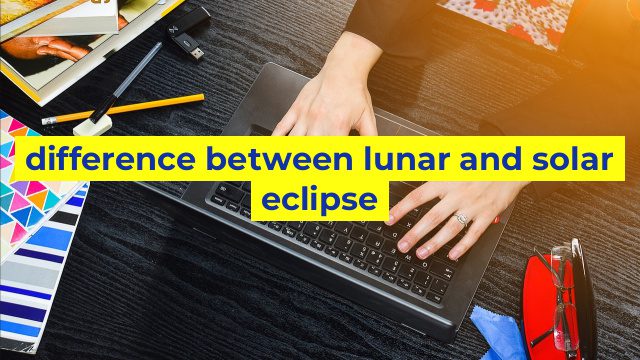Difference Between Lunar and Solar Eclipse: Explained
If you’re a fan of celestial events, then you’ve probably witnessed or heard of lunar and solar eclipses. Both are fascinating occurrences that can inspire awe and wonder in anyone who witnesses them. However, they are vastly different, and understanding their differences can help you appreciate them even more.
What is a Lunar Eclipse?
A lunar eclipse occurs when the Earth’s shadow falls on the moon, blocking out the sun’s rays. During a lunar eclipse, the moon appears to change color, turning a reddish-orange or a shade of brown. This phenomenon occurs only during a full moon, and can last for several hours.
One of the most significant characteristics of a lunar eclipse is that it’s visible from anywhere on the night side of the Earth. In other words, if you’re in a location where the moon is visible during the eclipse, then you’ll be able to witness it.
What is a Solar Eclipse?
A solar eclipse, on the other hand, occurs when the moon passes directly between the sun and the Earth, blocking the sun’s rays from reaching the Earth’s surface. During a solar eclipse, the sky may darken, and the temperature may drop, creating an eerie atmosphere.
Unlike lunar eclipses, solar eclipses are only visible in specific areas where the moon’s shadow falls on the Earth’s surface. These areas are known as the “path of totality.” Those who live outside the path of totality might see a partial eclipse, where only a portion of the sun is covered.
Key Differences Between Lunar and Solar Eclipses
One of the primary differences between lunar and solar eclipses is that lunar eclipses are visible from anywhere on the night side of the Earth, whereas solar eclipses are only visible within the path of totality. Additionally, lunar eclipses occur during a full moon, while solar eclipses take place during a new moon.
Another crucial difference is how these two types of eclipses affect the light. During a lunar eclipse, the moon’s color changes as it passes through the Earth’s shadow. In contrast, a solar eclipse can cause the sky to dim and the temperature to drop.
Conclusion
Both lunar and solar eclipses are fascinating events that capture the imagination of people worldwide. Knowing the differences between them can help you appreciate the unique characteristics of each. Regardless of which one you witness, you’ll undoubtedly be struck by the beauty and wonder of the cosmos.
Table difference between lunar and solar eclipse
| Features | Lunar Eclipse | Solar Eclipse |
|---|---|---|
| Definition | An event that occurs when the Earth passes between the sun and the moon, casting a shadow on the moon. | An event that occurs when the moon passes between the sun and the Earth, casting a shadow on the Earth. |
| Occurrence | Can occur up to 3 times a year | Can occur up to 5 times a year |
| Visibility | Visible from anywhere on the night side of Earth | Only visible from a narrow path on Earth where the moon’s shadow falls |
| Duration | Lasts for several hours | Lasts for a few minutes to a few hours, depending on location |
| Effect on wildlife | Minimal effect | Significant effect on animal behavior and activity |
